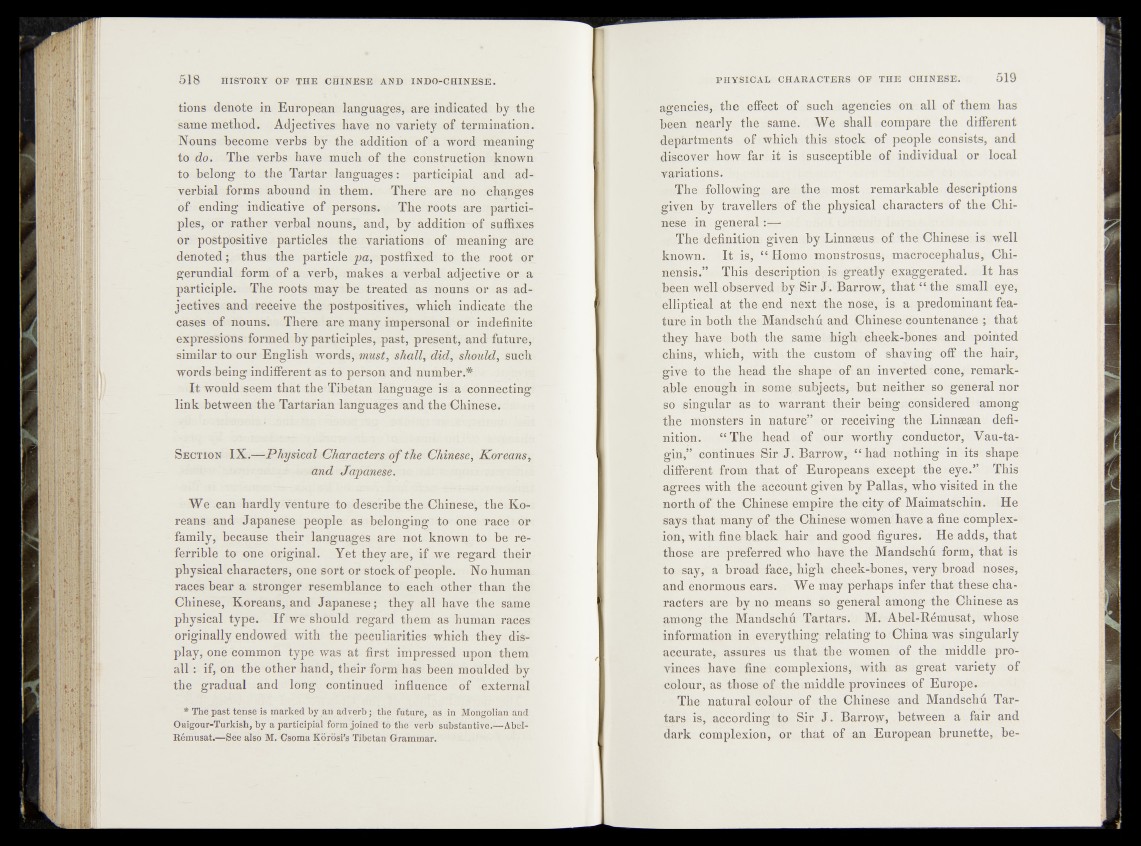
tions denote in European languages, are indicated by the
same method. Adjectives have no variety of termination.
Nouns become, verbs by the addition of a word meaning
to do. The verbs have much of the construction known
to belong to. the Tartar languages : participial and adverbial
forms abound in them. There are no changes
of ending indicative of persons. The roots are participles,
or rather verbal nouns, and, by addition-of suffixes
or postpositive particles the variationsof meaning are
denoted thus the particle pa, postfixed to the root p r
gerundial form, of a verb, makes a verbal adjective or a
participle. The roots may be treated as nouns or as adjectives
and receive the postpositives, which indicate the
cases of nouns. There are many impersonal or indefinite
expressions formed by participles, past, present, and future,
similar to our English words, must, shall, did, ,should, such
words being indifferent as to person and number.*
It would seem that the'Tibetan language is a connecting:
link between the Tartarian languages and the'fihinfepss
S ectio n IX.—-Physical Gharacters of th e GMnese, Koreans,
and Japanese.
We can hardly venture to describe the.Chinesei, the Ko-.
reans and Japanese people as belonging to one race ©r
family, because their languages are not knowp to; be re-
ferrible to phe original. Yet they are, if we regard their
physical characters* one sort or stock of people. No human
races bear a stronger resemblance to each other than the
Chinese, Koreans, and Japanese; they all have the same
physical type. If we should regard them as human races
originally endowed with the peculiarities which they display,
one common type was at first impressed upon them
a ll: if, on the other hand, their form has been moulded by
the gradual and long continued influence of external
* The past tense is marked by an adverb; the future, as in Mongolian and
Oaigonr-Turkish, by a participial form joined to the verb substantive.—Abel-
Remusat.—See also M. Csoma Korosi’s Tibetan Grammar.
agencies,| the effect, of such agencies on all of them has
been nearly the.same. We shall compare the different
departments ofwhich-,tkis stock of people consists, and
discover how far -it! is., susceptible of individual or local
variations. .
The following are. , Jhe . most remarkable descriptions
;^fee-n Wt travellers ,of tfee. physical characters of the Chinese
. general —
: • The. definition, given shy Linnseus of the Chinese is well
known. It ia;* “ Homo ropnstrosus, macrocephalus, Chi-
pensis.’hvitThis description, is* greatly exaggerated. It has
been well-observed by Sir Jv Barrow, that “ the, small eye,
Elliptical at the, end next, >the nose*, is a predominant feature
an both -the Mandschu and Chines.ercQuntenance ; that
they have; both the; same. high*; eheekrbo®es!\ and pointed
chins, which, with\the custom of shaving off the hair,
give to|!bedhead the shape of an inverted cone, remarkable
enough-.ina some« .subjects, but neither so. general nor
so singular as to warrant their; being ^considered among
the monsters in nature” or receiving the Linnsean definition.
; “ The head of our worthy conductor, Vau-ta-
gin,” continues Sir J. Barrow, “ had nothing in its shape
different from that of Europeans except the eye.” This
agrees with the account given by Pallas, who visited in the
north of the Chinese empire the-city of Maimatschin. He
says that many of the Chinese women; have a fine complexion,
with fine black hair and good: figures* He adds, that
those are preferred who have the Mandschu form, that is
to say, a broad face, high cheek-bones, very broad noses,
and enormous ears. We may perhaps infer that these characters
are by no means so general among the Chinese as
among the Mandschd Tartars. M. Abel-Rdmusat, whose
information in everything relating to China was singularly
accurate^ assures us that the women of the middle provinces
have fine; complexions, with as great variety of
colour, as those of the middle provinces of Europe.
• The natural colour of the Chinese and Mandschti Tartars
is, according to Sir J. Barrow» between a fair and
dark complexion, or that of an European brunette,. be